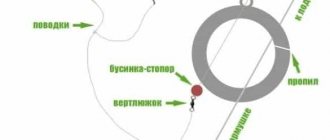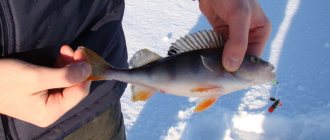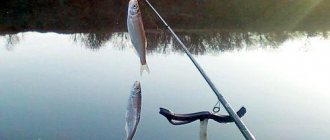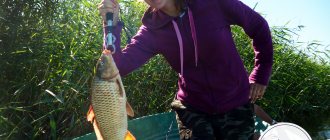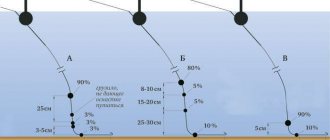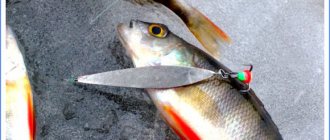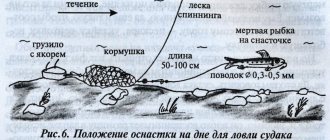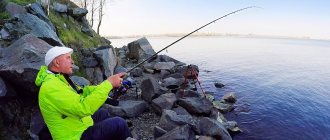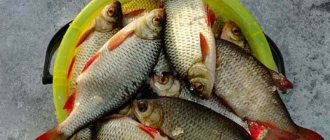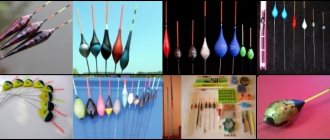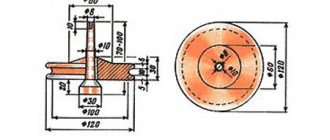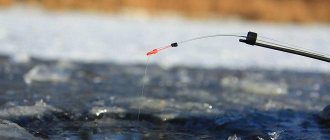What is an “egg” tackle?
“Egg” gear is a special weight consisting of two spherical weights attached to a pin, which serves to deliver equipment with bait along the cord to which the feeder is attached, to the top of this very feeder.
The peculiarity of the “egg” gear is that the bait is located in close proximity to the feeder .
The operating principle of the “egg” tackle is as follows:
- The weight is put on the bait cord and lowered to the feeder.
- The spring force of the steel wire prevents the “eggs” from opening.
- When hooking, and sometimes during a sharp bite, the tackle is pulled off the bait cord and allows the fisherman to fish without fear of the equipment and leashes getting tangled in the bait cord.
Fishing with eggs is only possible from a boat , since it is almost impossible to deliver a heavy feeder to the fishing site from the shore.
Pros and cons of gear
The advantages of the “egg” tackle are:
- the opportunity to fish in the current;
- the fact that the equipment with bait is located in close proximity to the feeder;
- the possibility of unhindered fishing for prey, since the main line, leashes and bait cord cannot get mixed up with each other;
- ease of making with your own hands;
- catchability of the gear.
There are practically no downsides to the “egg” tackle, only sometimes the “eggs” can open without a bite. In addition, fishing with more than one tackle poses certain difficulties.
Differences and similarities with the ring
Fishing with a ring has a longer history, and “eggs” are a modification of the ring that makes fishing more comfortable. Just like the ring, the “eggs” are designed to keep the bait rig in close proximity to the feeder. The difference is that when fishing with a ring, the weight remains attached to the bait cord during the fishing process, and when fishing with “eggs,” the load is released, and the likelihood of tangling the equipment and the bait cord is minimized.
Gear review
The principle of operation of the “egg” tackle is very similar to its analogue, the “ring”. It differs in the shape and fastening of the sinker. Used mainly in summer, sometimes in autumn. Used for fishing for carp, bream and other non-predatory fish species. You can fish with “eggs” if you have two components: a boat and a feeder (it comes separately and is submerged using a cord).
The first “weapon” (which will be discussed) has a sinker that consists of two lead balls connected to each other by wire with a loop for installation.
And the second one has a ring-shaped weight. In this case, the fishing line is attached to a specially made loop.
Both the ring tackle and the eggs are used only with the help of boats (sometimes from a cliff). Fishing with eggs is practiced mainly on the Don, but there are many stories in which the “tackle caught” on other bodies of water. Throwing something from the shore into the middle of a wide river is simply unrealistic - you need to sail by boat.
Gear requirements
Rod
A fishing rod, or simply a “board”, is a powerful fiberglass spinning rod approximately one meter long.
Coil
When fishing with “eggs,” many fishermen prefer to land their prey using a reel and only do it with their hands at the final stage. In such a case, a spinning reel seems more convenient, and you can use the most budget option.
Nod
The nod should not bend too much under the weight of the load and, at the same time, it should fix the bite. Spring nods with a bright ball at the end are optimal.
fishing line
At least 50 meters of monofilament fishing line with a diameter of 0.3-0.35 mm are wound onto the reel.
Sinker
The sinker is the actual “egg” tackle, the mass of which is determined by the depth and strength of the current at the fishing site.
Leashes
When using leashes, there are different rigging options. In the simplest case, one leash with a diameter of 0.15-0.18 mm is attached to a swivel tied to the main line. Its length can vary from 0.5 to 2 meters. There can be two leashes, but then they must have different lengths. They also use a “garland”, i.e. a piece of fishing line with a diameter of 0.22-0.26 mm, to which from two to six leashes are sequentially attached.
Bait cord
Monofilament fishing line with a diameter of 1 mm is usually used as a bait cord.
Feeder
The feeder is an important element of equipment when fishing with “eggs”. There are two types of feeders: “bucket” and “bag” . A “bucket” is a cylindrical feeder made of metal mesh with holes in the walls several millimeters in diameter, with a heavy lead base and a lid on top. A “bag” is a simple bag made of nylon mesh with a mesh of the required diameter, which depends on the size of the feed particles in the bait.
What does it consist of?
The fishing tackle includes the following components:
- special rod. You can't use regular fishing rods here;
- any reel. Even the simplest one will do - there are no special requirements for it;
- gatehouse He will signal the boatman when a fish bites;
- main cord. This line connects the rig to the rod;
- "garland". A number of leashes are attached to it;
- leashes with hooks;
- feeder with complementary foods;
- cargo. Those same “eggs”;
- delivery thread. It goes separately from the tackle, raises and lowers the container with bait;
- bead and swivel.
There are certain requirements for some of the above components. Let's start with the fishing rod. It should not be longer than one meter, otherwise many problems will arise when fishing from a boat. The principle works here: “The smaller the fishing tackle, the more convenient it is to use.”
The main cord should have a diameter of 0.31 - 0.36 millimeters. The optimal thickness of the “garland” on which leashes are placed is 0.23 – 0.26 mm. The leash requirements are as follows:
- length – 25-35 centimeters;
- diameter – 0.15 millimeters;
- the permissible quantity is from 2 to six pieces.
There is only one requirement for the feeding thread: it should not be too thick and noticeable (no more than 1 mm thick), because the fish, having noticed something wrong, will never come closer. Here you can use a fishing line that matches the color of the water (green monofilament is most often used).
How to make fishing tackle with your own hands
In order to make an “egg” load with your own hands at home you will need:
Tools:
- drill with a thin drill bit;
- wire cutters;
- pliers;
- hammer.
Materials:
- two lead spherical weights;
- pin.
The process of manufacturing the “egg” tackle consists of the following stages:
- An axial hole is drilled in each weight.
- The lock and sharp end of the pin are cut off.
- On a gas stove, the remaining ends of the pin are “released”.
- The ends of the pin are brought into a parallel position.
- The ends of the pins are threaded through the holes in the weights.
- The ends protruding 5-7 mm are bent closer to the surface of the loads.
- Using a hammer, the bent ends are finally driven into the surface of the loads.
Assembly
Correct assembly is carried out as follows:
- The rod is equipped with a reel with wound fishing line.
- The fishing line is threaded through the rings of the rod and the hole on the pre-installed nod.
- The fishing line is threaded into the ring of pins with weights.
- A bead with a diameter larger than the diameter of the pin ring is put on the fishing line to prevent the knot on the swivel from breaking.
- A swivel is tied to the main line.
- One or two leashes or the end of a fishing line from a “garland” are tied to the swivel.
Tactics and fishing techniques
In order to successfully catch fish using “eggs”, it is not enough to simply throw a feeder and wait for the weather by the sea. It's better to find fish first.
Expert opinion
Knipovich Nikolai Mikhailovich
Zoologist, hydrobiologist. I am interested in fishing at a professional level.
Healthy! An echo sounder will provide invaluable assistance in finding fish. On the screen of even the most budget echo sounder, fish of the carp family are clearly visible, having a large swim bladder, from which the echo sounder beam is reflected. In addition, with the help of an echo sounder you can find interesting bottom topography.
The fishing technique involves the use of a well-made feeder, correctly composed bait and fishing with properly mounted tackle.
Bait is placed in the feeder, which should have the following properties:
- include a fine fraction that is easily washed out and creates a cloud of turbidity;
- include the main component, which is slowly washed out of the feeder;
- contain a certain amount of animal additives (maggot, chopped worm);
- contain flavorings that are effective for catching the fish of interest to the fisherman in a given place.
The process of catching eggs looks like this:
- Having filled the feeder with bait, lower it to the bottom.
- An “egg” weight is placed on the bait cord.
- Place bait on the hooks and lower the tackle overboard.
Bream
When fishing for bream in the summer, you can wait quite a long time for a bite , since it takes a certain time for the fish to approach the feeder. But then the bites can follow one after another. Peas and millet should be added to the bait, to which bream is partial. Fishing for bream can be effective not only during the day, but also at night, and trophy specimens are often caught at night.
Perch
Perch, like bream, is a schooling fish, and having caught the first one, you can count on the continuation. In order to attract perch to the feeder, you should add as many animal components as possible to the bait, namely bloodworms and chopped worms, and then fishing can be successful.
Expert opinion
Knipovich Nikolai Mikhailovich
Zoologist, hydrobiologist. I am interested in fishing at a professional level.
Attention! The tackle should be lowered slowly to avoid the leashes getting caught in the main line. The main line must be taut when lowered.
Egg fishing technique
Professional fishermen recommend not using a motor when fishing for eggs in the summer, but rowing with oars. Large peaceful individuals are characterized by high caution, so you should not create unnecessary noise.
First you need to carefully lower the anchor into the water so that the boat does not move under the influence of the current. Then a fish feeder is lowered to the bottom. After baiting, the most important point remains - installing the gear, but some fishermen advise waiting 5 minutes after installing the feeder so that the bait attracts fish.
The tackle must be secured separately from the feeding cord so that in the future you do not have to frequently unhook and attach it. The bait is attached to the hooks. Then you need to throw the rig a little further from the feeder.
Alternatives
Alternatives to the “egg” tackle are the following:
- Ring. You can fish with a ring just as successfully as with “eggs”, but the fixed nature of this equipment on the bait cord sometimes gives the angler trouble when landing prey.
- Feeder. For feeder fishing, much shorter rods are used than when fishing from the shore. Otherwise, the fishing technique is the same as for coastal fishing. You can fish vertically, or you can throw feeders some distance from the boat, thereby catching cautious fish that are afraid of the boat. It is quite acceptable to use two or three rods.
- Side rod or pickerel. When using “onboard feeders”, one feeder is used, and there can be several fishing rods. In this way, you can catch more fish, but provided that the fish are not as attached to the feeder as when fishing with “eggs” or with a ring. In addition, in the current, fishing rods sometimes get tangled, and, in addition, free fishing rods can become entangled in fish that are being fished out.
How to make catchy eggs or a ball for perch fishing
Independently of each other, fishermen from several countries invented very catchy gear for catching perch. It is slightly different in size and shape, but the principle of operation is the same. This tackle is called Velniukas in Lithuania, but in Ukraine it is called eggs. The tackle is a lead egg of normal or pathological shape, in which a hole is made (punched), sometimes called a piercing hole. The egg can be either natural color or painted (so-called krashanka).
A fishing line with a thickness of 0.2 - 0.25 mm is threaded through the hole, hooks No. 8-12 according to the European classification are placed on it on both sides of the eggs (not tied!), and on top the ends of the fishing line are attached to a triple swivel. In Lithuania, fly fishing hooks are used and imitation bloodworms are crocheted with red and black threads.
This is done not so much for the purpose of increasing catchability, but for the sake of greater compliance with the name (velniukas in translation - “devil”), thus, we can conclude that according to Lithuanian mythology, the devil certainly has red horns and an egg instead of a face, which indicates a low elaboration of mythological ideals or simply about the complete disrespect of the Balts for dark forces.
In Ukraine, due to the greater love of life of our people, live bloodworms are usually put on hooks. It bites better, but, firstly, the bloodworms must be changed often, since the perch eats them, and secondly, pierced eggs with a string attached are exotic, but normal, but when worms appear in them...
The principle of fishing with eggs or bulldozer is very simple. The fisherman lowers his eggs into the hole and, when they reach the bottom, makes two or three gentle jerks, i.e. knocks eggs on the bottom. The turbidity raised at the same time attracts perch, as well as the eggs themselves. After a series of blows to the eggs with the bottom, you need to do this - move the nod slightly, in this case it is no longer the egg itself that plays, but the hooks tied to it with bloodworms or its imitation. Perch loves to pull eggs on the so-called. “tables” - large, flat places with a depth of approximately 3-4 m.
The shape and size of your eggs can greatly influence the bite depending on the structure of the bottom - on a hard sandy bottom it is advisable to use eggs of greater weight and drop-shaped shape, on a muddy bottom a small oblong egg will be enough. In general, it has been noticed that the larger the fisherman’s eggs, the larger the perch will grab for them. However, if there is no large perch, it is advisable to make and replace the eggs with smaller ones, otherwise you may be left without a catch.
And in conclusion, a few words on safety precautions. It is advisable to use a thicker main line - approximately 0.25 - 0.30 mm, since even on tables there are submerged objects and writhings, on which eggs can easily get caught. In this case, a bumper will be very useful to you, unless, of course, you are too bothered by blows to your eggs in winter, and also by the fact that after exposure to a heavy bumper, your eggs may simply become unusable - the material there is quite soft, and the shape is important.
Moreover, the largest perch will be in the writhing state, which, if the main line is not thick enough, can simply bite off your eggs, and then in the evening you will be in a bad mood, and in response to the advances of your bored wife you will have to explain that because of your inattention you while fishing, the perch tore off the last eggs...
Based on site materials
